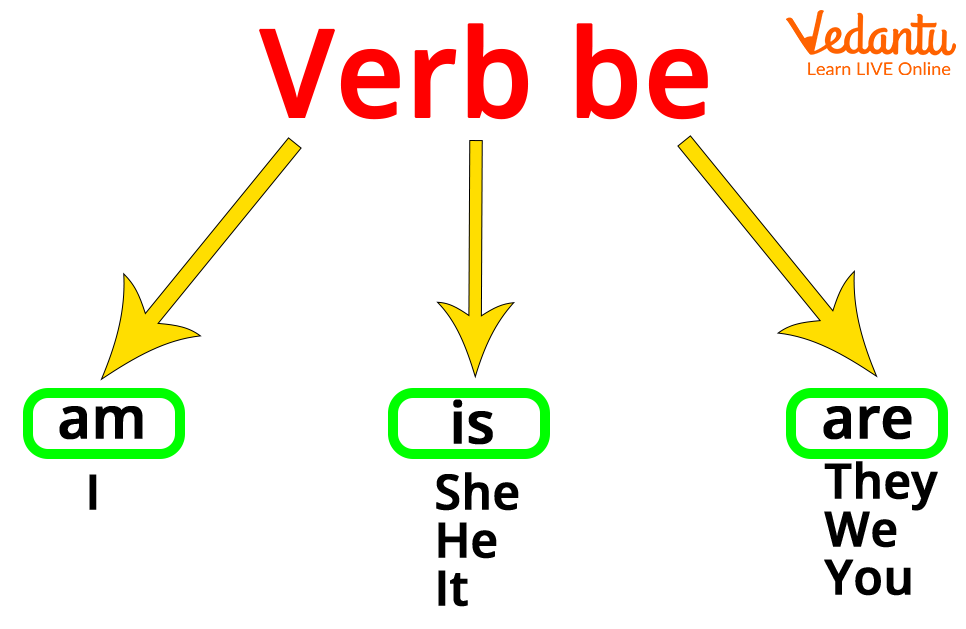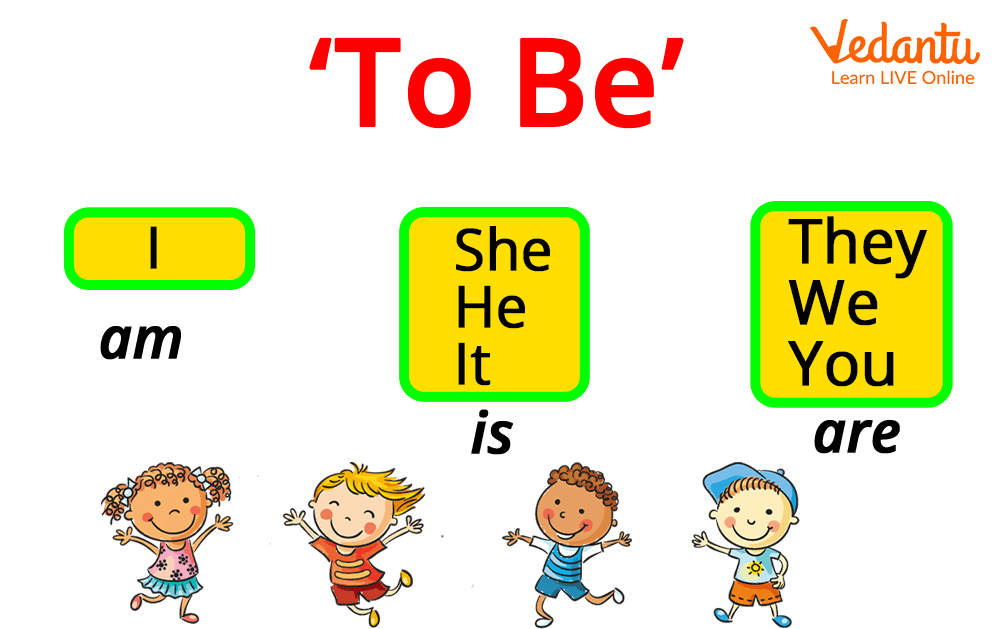




To Be Verbs List
Verbs play a crucial role in communication, especially in English, as they express the actions of a subject. Common action verbs like speak, jump, and run describe what someone or something is doing. However, among all the verbs, one of the most frequently used phrases in the English language is the "to be" verb.
At first, learning verbs—especially To Be Verbs—can feel tricky for children. The idea of verbs might be a bit challenging to grasp, but with regular practice through fun exercises and engaging activities, it becomes much easier. Since "to be" verbs are used so often and for various purposes, kids need to master them early to build a strong foundation in language skills.

Illustration of “to be” Verb
How to Use the “to be” Verb
The "To be" verb is basically used to describe someone or something. In English, it can be used to express different things which are in accordance with the context. The most common use of the verb "to be" is to talk about nationality, names, age, feelings and professions, especially when talking in the present tense.
Forms of “to be”
The to be verb is written according to the tense of the verb whether it is past tense, future tense or even in mixed tenses since this word is highly regular in nature. They also vary with the subject. Let's see which form the verb takes when used next to the subject.
Base form: Be
This is one of the most basic forms of the verb that we can find in the dictionary. It is mostly used when using imperatives and also as infinitives. Some of the examples are:
Be nice to everyone. (imperative)
I like to be at home. (infinitive)
Present form
Here “to be” is mainly used for simple present and its form and meaning can change depending on its use of it in the context. The present form of the “to be” verb can be shortened when used in the simple present form.
So here is the entire table of to be for all the subjects in both long and short forms for negative as well as affirmative sentences:
Few of the examples of these sentences with the “to be” verb:
She is Naina.
He is 12 years of age.
Naina is very happy today.
We are not from Australia.
You are not a singer, you are a painter.

Illustration of "to be" Verb in the Present
Past: Was/Were
When we are talking about the past tense, the “to be” verb changes its form again. There is a table of how it appears with the different subject pronouns.
Few of the examples of these sentences with the “to be” verb:
I was at home yesterday.
You were 12 years old last year.
Naina and Raju were students, now they are engineers.
It was cloudy a while ago.
Past Participle: Been
This is the form of the “to be” verb used with the perfect and passive tenses, and it is the same for all the subjects. It is also used in the form of adjectives sometimes.
I have been busy all day.
Sita and Geeta have been studying for an hour.
He has been teaching for a year now.
Continuous: Being
To make a continuous tense this continuous form of the verb is used in English. It is the same for all the subjects just like the past participle.
Rani is being Helpful
Passive Form
In both present and past forms of the verb ‘to be’ can be used to make passive sentences.
His house was built in the mountains
The program is being recorded right now.
Conclusion
To conclude, verbs are an integral part of a sentence. Proper usage of verbs helps us to understand the sentence structure. It builds a strong foundation in the process of writing and speaking English. The ‘to be’ verb helps students to learn the basics of verb and their usage.
FAQs on To Be Verbs: Explanation with Examples
1. How do you explain the verb “to be”?
Are, am, is, was, were, been and being are all to be verbs. They are basically used to describe the condition of the people, things, places and ideas to us. For instance, they could tell us the nationality of the subject of the job or other traits of the subject including the age of the subject.
2. What kind of verb is be?
It is considered as an irregular verb because the past simple and the past participle of this verb do not end in “ed”.
3. Give To Be Verbs examples.
Present Tense:
I am happy.
You are kind.
She is a teacher.
Past Tense:
I was tired.
They were excited.
Future Tense:
He will be here soon.
We will be ready by 5 PM.
4. What are the different forms of To Be Verbs in English grammar?
The "to be" verbs vary by tense and subject. In the present, use "am" (I), "is" (he/she/it), and "are" (we/you/they). In the past, we used "was" (I/he/she/it) and "were" (we/you/they). The future tense uses "will be" for all subjects. Other forms include "to be" (infinitive), "being" (present participle), and "been" (past participle).
5. What are some fun exercises to help children practice 'to be' verbs?
Some To Be Verb Exercises to help children practice "to be" verbs include fill-in-the-blanks, role-playing, sentence matching, picture descriptions, and verb bingo.
6. What is an example of a "to be" verb in a sentence?
Example: "She is happy." In this sentence, "is" is the "to be" verb.
7. When do we use "been" as a "to be" verb?
"Been" is used with helping verbs like "have" and "has" to describe something that has happened or continued over time. Example: "I have been busy."
8. How can I avoid overusing "to be" verbs in writing?
To avoid overuse, try using active verbs or rephrasing sentences. For example, instead of "She is tired," you can say "She feels tired."
9. Is "am" a "to be" verb?
Yes, "am" is a "to be" verb and is used with the subject "I." Example: "I am a student."
10. How do "to be" verbs help form questions?
"To be" verbs help form questions by changing their position in the sentence. Example: "Are you ready?" Here, "are" is the "to be" verb used to form the question.









